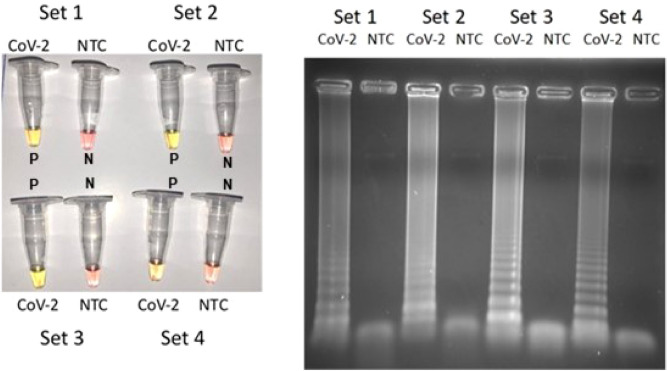Colorimetric RT-LAMP SARS-CoV-2 diagnostic sensitivity relies on color interpretation and viral load
The use of RT-LAMP (reverse transcriptase-loop mediated isothermal amplification) has been considered as a promising point-of-care method to diagnose COVID-19. In this manuscript we show that the RT-LAMP reaction has a sensitivity of only 200 RNA virus copies, with a color change from pink to yellow occurring in 100% of the 62 clinical samples tested positive by RT-qPCR. We also demonstrated that this reaction is 100% specific for SARS-CoV-2 after testing 57 clinical samples infected with dozens of different respiratory viruses and 74 individuals without any viral infection. Although the majority of manuscripts recently published using this technique describe only the presence of two-color states (pink = negative and yellow = positive), we verified by naked-eye and absorbance measurements that there is an evident third color cluster (orange), in general related to positive samples with low viral loads, but which cannot be defined as positive or negative by the naked eye. Orange colors should be repeated or tested by RT-qPCR to avoid a false diagnostic. RT-LAMP is therefore very reliable for samples with a RT-qPCR Ct < 30 being as sensitive and specific as a RT-qPCR test. All reactions were performed in 30 min at 65 °C. The use of reaction time longer than 30 min is also not recommended since nonspecific amplifications may cause false positives.
Authors
Mateus Nóbrega Aoki; Bruna de Oliveira Coelho; Luiz Gustavo Bentim Góes; Paola Minoprio; Edison Luiz Durigon; Luis Gustavo Morello; Fabricio Klerynton Marchini; Irina Natassja Riediger; Maria do Carmo Debur; Helder I Nakaya; Lucas Blanes
External link
Publication Year
Publication Journal
Associeted Project
Microbiology or Immunology
Lista de serviços
-
Genomic analyses reveal broad impact of miR-137 on genes associated with malignant transformation and neuronal differentiation in glioblastoma cells.Genomic analyses reveal broad impact of miR-137 on genes associated with malignant transformation and neuronal differentiation in glioblastoma cells.
-
RNA-Binding Protein Musashi1 Is a Central Regulator of Adhesion Pathways in Glioblastoma.RNA-Binding Protein Musashi1 Is a Central Regulator of Adhesion Pathways in Glioblastoma.
-
MicroRNA Transcriptome Profiling in Heart of Trypanosoma cruzi-Infected Mice: Parasitological and Cardiological Outcomes.MicroRNA Transcriptome Profiling in Heart of Trypanosoma cruzi-Infected Mice: Parasitological and Cardiological Outcomes.
-
Genome mapping and expression analyses of human intronic noncoding RNAs reveal tissue-specific patterns and enrichment in genes related to regulation of transcription.Genome mapping and expression analyses of human intronic noncoding RNAs reveal tissue-specific patterns and enrichment in genes related to regulation of transcription.
-
Antimicrobial peptide LL-37 participates in the transcriptional regulation of melanoma cells.Antimicrobial peptide LL-37 participates in the transcriptional regulation of melanoma cells.
-
Down-regulation of 14q32-encoded miRNAs and tumor suppressor role for miR-654-3p in papillary thyroid cancer.Down-regulation of 14q32-encoded miRNAs and tumor suppressor role for miR-654-3p in papillary thyroid cancer.
-
Integration of miRNA and gene expression profiles suggest a role for miRNAs in the pathobiological processes of acute Trypanosoma cruzi infection.Integration of miRNA and gene expression profiles suggest a role for miRNAs in the pathobiological processes of acute Trypanosoma cruzi infection.
-
Integrative Biology Approaches Applied to Human DiseasesIntegrative Biology Approaches Applied to Human Diseases
-
Proteomics reveals disturbances in the immune response and energy metabolism of monocytes from patients with septic shock.Proteomics reveals disturbances in the immune response and energy metabolism of monocytes from patients with septic shock.
-
Genomics, epigenomics and pharmacogenomics of Familial Hypercholesterolemia (FHBGEP): A study protocol.Genomics, epigenomics and pharmacogenomics of Familial Hypercholesterolemia (FHBGEP): A study protocol.
-
Melatonin-Index as a biomarker for predicting the distribution of presymptomatic and asymptomatic SARS-CoV-2 carriersMelatonin-Index as a biomarker for predicting the distribution of presymptomatic and asymptomatic SARS-CoV-2 carriers
-
Profiling plasma-extracellular vesicle proteins and microRNAs in diabetes onset in middle-aged male participants in the ELSA-Brasil study.Profiling plasma-extracellular vesicle proteins and microRNAs in diabetes onset in middle-aged male participants in the ELSA-Brasil study.
-
Big Data and machine learning in cancer theranosticsBig Data and machine learning in cancer theranostics
-
Genomic positional conservation identifies topological anchor point RNAs linked to developmental loci.Genomic positional conservation identifies topological anchor point RNAs linked to developmental loci.
-
Integrative systems immunology uncovers molecular networks of the cell cycle that stratify COVID-19 severityIntegrative systems immunology uncovers molecular networks of the cell cycle that stratify COVID-19 severity

